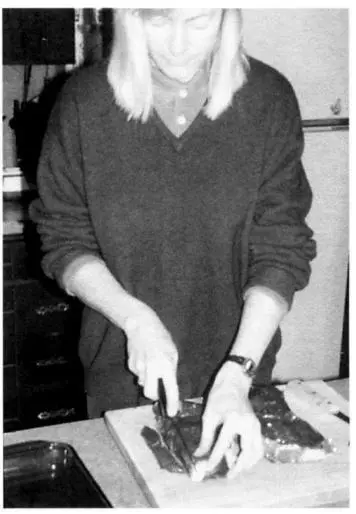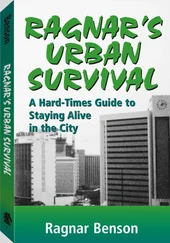Ragnar Benson - Ragnar's Urban Survival - A Hard-Times Guide to Staying Alive in the City
Здесь есть возможность читать онлайн «Ragnar Benson - Ragnar's Urban Survival - A Hard-Times Guide to Staying Alive in the City» весь текст электронной книги совершенно бесплатно (целиком полную версию без сокращений). В некоторых случаях можно слушать аудио, скачать через торрент в формате fb2 и присутствует краткое содержание. Год выпуска: 2009, ISBN: 2009, Жанр: Старинная литература, на английском языке. Описание произведения, (предисловие) а так же отзывы посетителей доступны на портале библиотеки ЛибКат.
- Название:Ragnar's Urban Survival: A Hard-Times Guide to Staying Alive in the City
- Автор:
- Жанр:
- Год:2009
- ISBN:1581600593
- Рейтинг книги:5 / 5. Голосов: 1
-
Избранное:Добавить в избранное
- Отзывы:
-
Ваша оценка:
- 100
- 1
- 2
- 3
- 4
- 5
Ragnar's Urban Survival: A Hard-Times Guide to Staying Alive in the City: краткое содержание, описание и аннотация
Предлагаем к чтению аннотацию, описание, краткое содержание или предисловие (зависит от того, что написал сам автор книги «Ragnar's Urban Survival: A Hard-Times Guide to Staying Alive in the City»). Если вы не нашли необходимую информацию о книге — напишите в комментариях, мы постараемся отыскать её.
Ragnar's Urban Survival: A Hard-Times Guide to Staying Alive in the City — читать онлайн бесплатно полную книгу (весь текст) целиком
Ниже представлен текст книги, разбитый по страницам. Система сохранения места последней прочитанной страницы, позволяет с удобством читать онлайн бесплатно книгу «Ragnar's Urban Survival: A Hard-Times Guide to Staying Alive in the City», без необходимости каждый раз заново искать на чём Вы остановились. Поставьте закладку, и сможете в любой момент перейти на страницу, на которой закончили чтение.
Интервал:
Закладка:
As a final precaution, all meat canned at home using an open water bath--not a pressure cooker-should be cooked in an open pan an additional 10 minutes after opening prior to serving. By now it is obvious why many city survivors plan to try to use a freezer of some sort to preserve their meat and vegetables. Freezing takes far less total energy i:z the long run, it keeps everything in a more appetizing and nutritious form, and it is much easier when time is at an incredible premium.
Vegetables not frozen quickly must be canned. Freezing is better because of the fewer supplies and energy required. Freezing and canning are similar in their initial stages. Here is how to freeze vegetables:
To freeze vegetables such as beans and peas, first pick, clean, and thoroughly wash therm Blanch them in boiling water for 10 minutes to stop the enzyme action. Cool blanched batches of vegetables for 5 minutes in running water and then spread thinly on cookie sheets or in shallow pans. Place the pans of vegetables in the freezer. After freezing, break individual pieces apart and pack them into plastic storage bags that are again placed in the freezer.
Canning vegetables begins in a similar fashion. Again, start by washing, but wash more thoroughly than with freezing. All errant garden dirt must be removed. Huge amounts of labor are required, so much that canning may never be practical for some hard-core city survivors.
Blanch cleaned vegetables at a rolling boil for 10 minutes. Do not cool as when vegetables are frozen. Place still piping-hot vegetables in quart canning jars. Pack the jars as tightly as possible, adding one teaspoon of salt and filling to the top with boiling water.
Process the jars in an open water bath for 4 hours at a rolling boil or in a pressure cooker 1 1/2 hours. All vegetables processed in an open water bath must be cooked 10 additional minutes in an open pan before serving. Most vegetables take on a pretty bedraggled look by the end of processing.
Successfully placing canning lids on jars takes practice. Break new lids apart and place them in a shallow pan of boiling water. Boil for 10 minutes. Wipe the rim of each filled canning jar with a clean (freshly washed), dampened cloth to remove debris and grease. Remove the lids one at a time from the boiling water and place firmly on canning jars. There are two sizes of lids, little and big. Big-mouthed jars are generally surplus mayonnaise jars or whatnot, which quickly break in service. Initially a generous supply of each size lid is required. Lids are not reusable.
Cinch the lids down firmly with brass retainer rings made expressly for this purpose. When the contents of the jar boils in the boiling water bath, all air in the jar will be driven out. On cooling, the lids draw down on the jars, sealing them.
Hanging
It is a very old-fashioned method, but fresh meat can be hung and preserved for several weeks to 2 months in cool to modestly cold climates. How cold? Cool enough that no bugs are out. Generally about 38 to 40 degrees, max.
Hang the halved carcasses in a cool, draft-free area away from traffic and warmth of the living area. Gritty, airborne dust on the meat is not particularly nice. Throw a light bedsheet-weight cover on hanging meat to keep it clean.
In about 10 days the meat will become discolored to a very deep red or even maroon. Surface mold will form. Neither of these harms the edibility of the meat in the least. Toward the last the meat may even start to smell a bit. It's OK, but just hurry up with the eating, freezing, or drying before it gets much worse.
Will city survivors have a place to hang meat? Maybe out on a porch or balcony. Experience indicates that life will get extremely cramped in some apartments. It will definitely not be like the normal routines we currently enjoy. Hanging meat may not be possible, but it won't even be an option if you don't know about the method.
Jerking
Outside of freezing, jerking meat is certainly the simplest, easiest, safest, and perhaps most nutritious method of adding shelf life to very perishable products. This fact was dramatically brought home to me while watching allegedly primitive rural Africans quickly, easily process as many as four 400- to 500pound critters per day into dried meat. They called it biltong. Performance of this wondrous deed was done without equipment or supplies. Butcher knives and a wild thorn bush rack were their most sophisticated equipment.
Little or no difference exists between jerky and biltong, except that the latter tends to be made from ostrich, oryx, or giraffe meat. Rural Africans produce their jerky by hanging sliced pieces of meat on a thorn bush out in the direct sun in places where dust is minimal and gentle winds blow. The rule to follow in making jerky is that although use of some modern accouterments adds to processing efficiencies and perhaps aesthetics, only heat and air movement are really necessary to produce a nutritious, delicious, satisfactory product.
Marinating jerky meat isn't entirely necessary, but most survivors pretreat their surplus meat before starting the actual jerking process. These homemade marinating concoctions range from powdering with fine-ground pepper to soaking in a water, pepper, and salt mixture, to using N orcestershire sauce to using plain old honey and pepper.
Some folks don't like any of these, and fortunately these are not a requirement for good jerky. Others enjoy the peppery, salty taste these condiments carry into the meat.
We do know that fine-ground pepper and salt soaked into jerky both adds taste and reduces the chore of keeping pesky blowflies at bay till heat levels rise and the meat is sufficiently dry to avoid being fly-blown. 'Under nonemergency conditions, similar results can be achieved by starting the jerky out for a few minutes in a microwave. Or the entire job can be done on a kitchen range. By whatever source of heat. be cautious that the process proceeds sufficiently slowly that the meat dries rather than cooks.
Sanitation, always a problem when producing jerky, is better accomplished by working in the kitchen. Some natural gas and bottled gas ranges or burners may be operational, but it's best not to count on these in a real -witty-gritty survival situation.
Unless it is summer in northern latitudes or winter in southern Texas or Arizona, outdoor temperatures will not be suitable for natural jerky production. No problem! Large quantities of excellent jerky have been made around an open fire with snow on the surrounding ground. It would have seemed easier working on the ground level, but some survivors in Kuwait City and in Beirut cracked the concrete in their high-rise apartments when they built open fires on the bare cement floor. If it comes to that, find an old steel sheet, car fender, or whatever to protect the floor.

They are gone now, but at one time we shared the use of a set of two old steel bedsprings. Frequently we erected these in an inverted V over an open fire forming a kind of reusable drying rack. A rack could have been built out of wood, but the bedsprings were slick and easy.
Over the years, hundreds of pounds of fish, ducks, rabbits, and pheasants, as well as deer, elk, and moose meat were processed over these makeshift racks. City survivors will probably cure rat, cat, dog, and perhaps fish, geese, ducks, and pigeons on their racks. Something similar could be scroungeable in almost any city.

Cut meat into thin strips before jerking.
Читать дальшеИнтервал:
Закладка:
Похожие книги на «Ragnar's Urban Survival: A Hard-Times Guide to Staying Alive in the City»
Представляем Вашему вниманию похожие книги на «Ragnar's Urban Survival: A Hard-Times Guide to Staying Alive in the City» списком для выбора. Мы отобрали схожую по названию и смыслу литературу в надежде предоставить читателям больше вариантов отыскать новые, интересные, ещё непрочитанные произведения.
Обсуждение, отзывы о книге «Ragnar's Urban Survival: A Hard-Times Guide to Staying Alive in the City» и просто собственные мнения читателей. Оставьте ваши комментарии, напишите, что Вы думаете о произведении, его смысле или главных героях. Укажите что конкретно понравилось, а что нет, и почему Вы так считаете.











